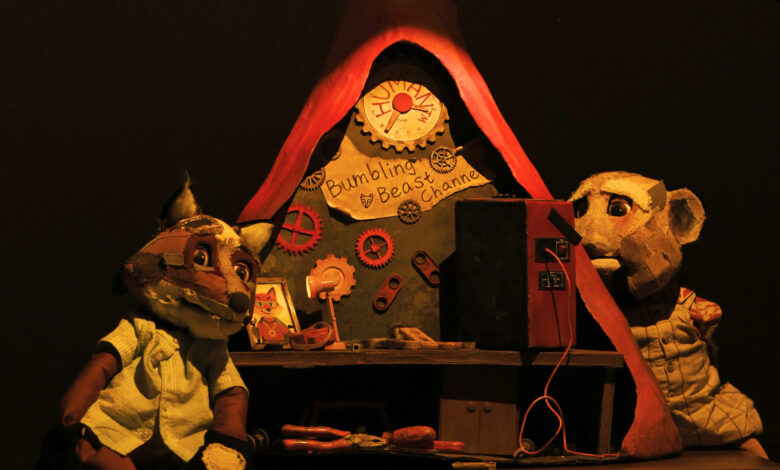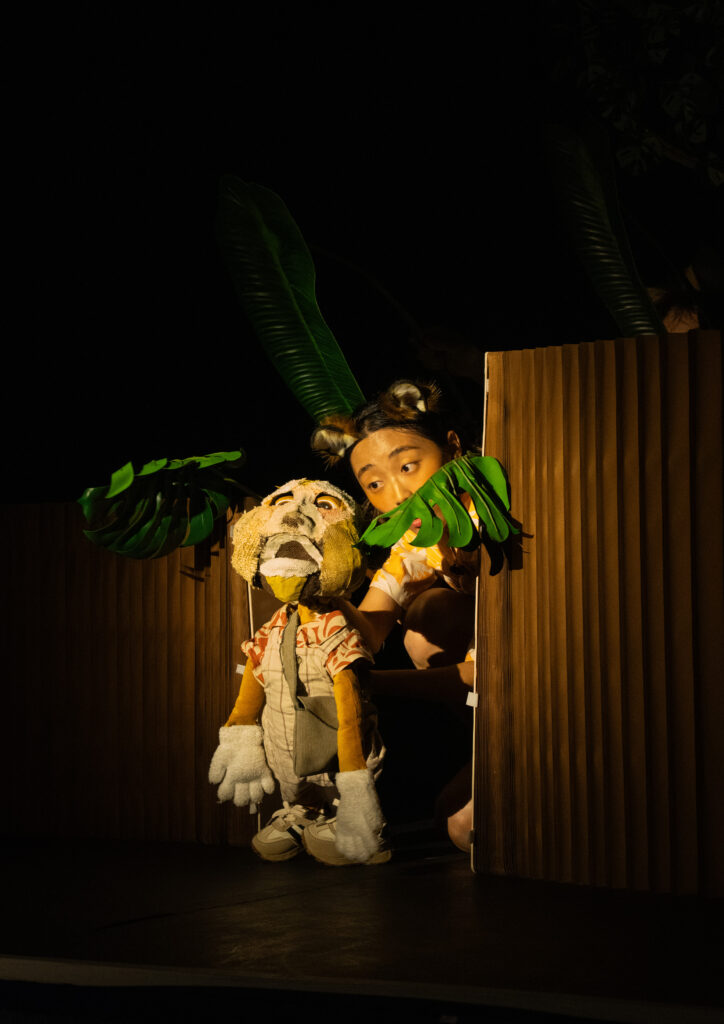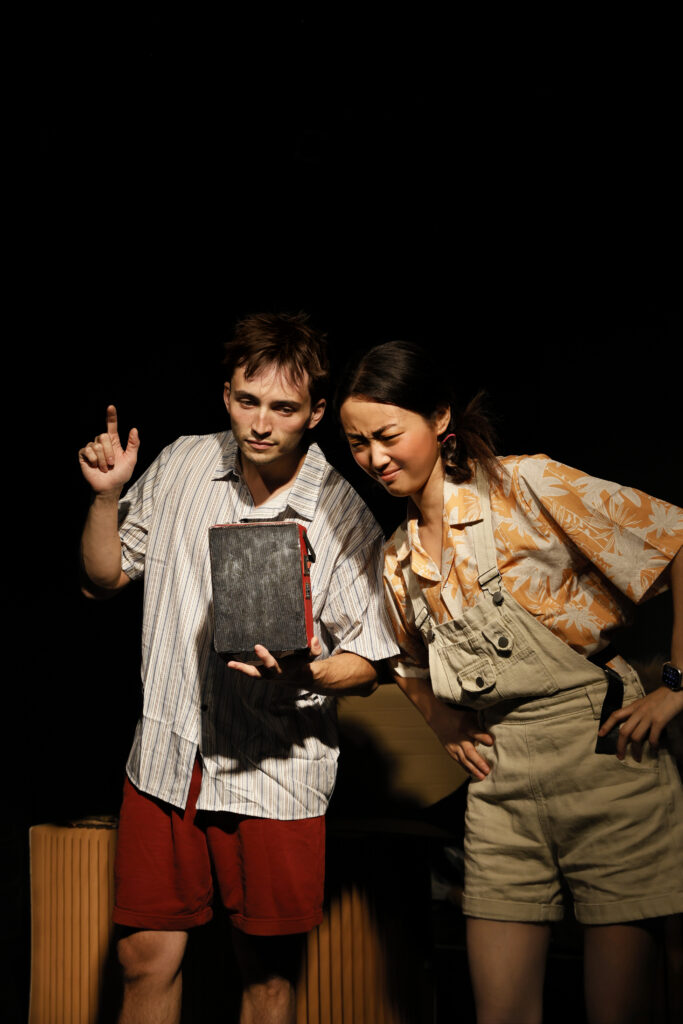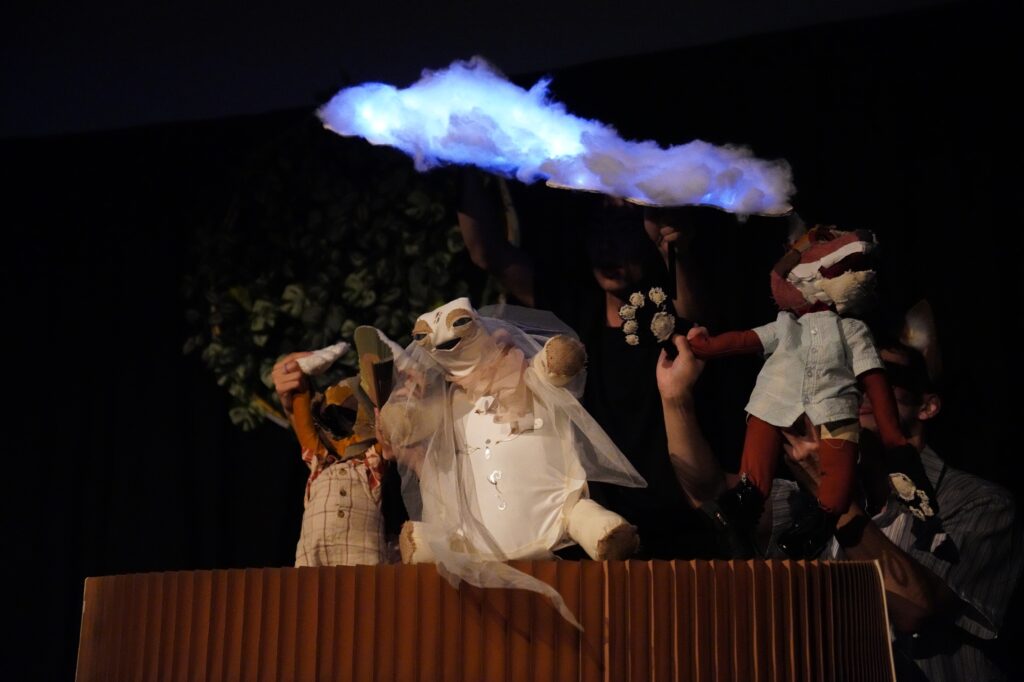Interview: A Rumble in the Jungle

Roarrr Theatre Company talk about Here Comes Gudong
Roarrr Theatre Company brings their award-winning show for children Here Comes Gudong to the Lyric Hammersmith for one day only (4 October, performances at 11am and 1pm). Described as a sensory show with a crossover between Chinese and Western cultures, we were interested to know more about it, so called up the team of Portia Yuran Li (writer, director, and producer), Effie Gu (Production and Set Designer), Mingyu Ding (Movement Director, Music Director and Sound Designer), Aidan Harris (puppeteer), Elaine Li Quan (stage manager) and Inini Xinyi Yin (Video & Sound Operator) to find out a bit more.
What prompted you to devise a story for children about ecology?
Portia: The prompt came from a shared core belief that runs through every department of this production: to make ecological awareness an exciting adventure, not a lesson. “Here Comes Gudong” is based on a Chinese tale, but caring for the environment knows no borders. That’s why we chose to weave ecology in as a hidden narrative thread—not as a lecture, but as an experience felt through the characters’ journeys and magical stage moments. So Roarrr theatre becomes a miniature model for the world we hope children can imagine and build.
Effie: The prompt came from my core belief as a designer working in eco-scenography. I wanted to prove that magic and sustainability aren’t opposites. So, we deliberately built our world from recycled treasures – cardboard, old toys, forgotten bits and bobs. This approach allowed me to show children, firsthand, that protecting our planet can be a creative and wondrous act, starting right there in the theatre.
The production is described as a sensory show. What does this entail?
Ming: As the movement and music director for Here Comes Gudong, my approach was deeply connected to the show’s core quest: finding the source of the “Gudong” sound. We crafted a layered soundscape that blends natural sound effects with artificial ones, while also incorporating traditional Chinese instruments into the score. This creates an auditory journey that feels both organic and enchanted. Similarly, the movement is not just dance – it’s a physical narrative. Every gesture and sequence is designed to express discovery, curiosity, and emotion, helping to tell the story through the body as much as through sound and dialogue.
Aidan:As the puppeteer and cast of the Fox, we’ve created a minimalistic world with soothing colors and gentle lighting—not to restrict, but to focus and calm, allowing young audiences to engage gently with their senses.
For example, in one scene, I invite children to listen closely to sounds from an old radio, encouraging active listening. At the same time, the detailed “Gear Kingdom” offers a rich visual landscape to explore. It’s about inviting them into the story through sight and sound in an unhurried, immersive way—never overwhelming.
Quan: From my perspective as the stage manager, our most important job is to be guardians of the children’s experience. We carefully balance every element—from the soft lighting to the subtle sounds—to ensure the world of the play is inviting but never intimidating. It’s about nurturing their senses gently over the 45 minutes, so that when they leave, they carry with them a little more wonder for the natural world and a little more bravery for their own journeys, just like the heroes of our story.
Portia: We deliberately paired classical Chinese text on screen with the actor’s English narration. This allowed the audience to visually appreciate the elegance of Chinese written culture while following the story effortlessly. The goal was never to teach, but to immerse them in a holistic aesthetic experience where East and West complement each other.
Can you tell us about the types of puppetry that are used?
Jessica: Our puppets are given a second life from recycled treasures—fabrics, wood scraps, and strings. Take the monkey and fox, for example. They are operated from above by a handle on their heads. With one hand, the puppeteer can pull triggers to make their mouths chatter and eyes blink, while the other hand brings them to life by moving their agile, jointed arms and legs. This two-handed technique allows them to be incredibly expressive and full of character.
There’s also some video work going on. How is that blended into the performance?
Inini: The video design is closely woven into Chuan’s identity as an explorer. On stage, Chuan carries a camera to capture the landscapes discovered along the journey. Our first magical moment comes when Chuan photographs: the live audience magically appears in the video as little animals watching the adventure.
Beyond that, the video also offers another way of seeing: miniature stage models are filmed up close and projected, allowing the audience to dive into small wonders of Chuan’s world.
One of the most memorable sequences accompanies the entrance of Jingwei, the mythical Chinese bird. Here, the video shifts into a lyrical backdrop inspired by traditional aesthetics—shadow-puppet waves blend with ink-wash brushstrokes, adding a subtle yet powerful cultural layer that stays with the audience long after the curtain falls.
The show won the Keep It Fringe Award at Edinburgh Fringe this year and was nominated for the Intercultural Connections Award – congratulations! How have UK audiences responded to its crossover of Chinese folklore and Western culture?
Portia:It has been most gratifying that seeing how UK audiences, especially families, have embraced the fusion not as a barrier, but as a bridge. The response has been wonderfully warm. For instance, the moment our shadow-puppet rendition of the mythical bird Jingwei takes flight on stage, you can hear a collective, awe-inspired ‘wow’ ripple through the auditorium. That’s the magic of visual storytelling—it transcends language.
The narrative integration feels seamless because the themes are universal: curiosity, courage, and caring for our world. These values resonate deeply across cultures. The awards are a tremendous honour, but the true success for me, as both director and producer, is seeing children and adults alike leave the theatre not just entertained, but connected to a piece of Chinese folklore through a shared, joyful experience.
Thanks to the team at Roarrr Theatre for their time. Here Comes Gudong plays at Lyric Hammersmith on Saturday 4 October, with two performances (11am and 1pm).









